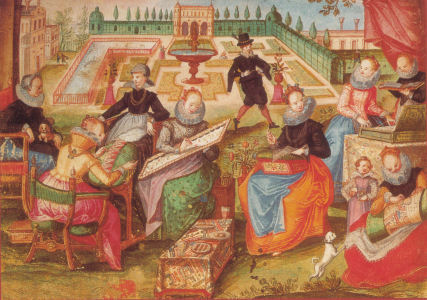

William Shakespeare wrote Twelfth Night around 1601-02, and its first recorded performance is in 1602. In this play, Duke Orsino says:
|
O, fellow, come, the song we had last night. |
This is an early reference to bobbin lace: weave their thread with bones. Small bones used to be used as bobbins, to wind the thread round. Even today, bobbins are sometimes made of bone. Bobbin lace is essentially weaving, with the pins creating gaps to form the patterns.
If you want to know about the song that Duke Orsino asked for, here it is:
|
Come away, come away, death, And in sad cypress let me be laid; Fly away, fly away breath; I am slain by a fair cruel maid. My shroud of white, stuck all with yew, O, prepare it! My part of death, no one so true Did share it. Not a flower, not a flower sweet On my black coffin let there be strown; Not a friend, not a friend greet My poor corpse, where my bones shall be thrown: A thousand thousand sighs to save, Lay me, O, where Sad true lover never find my grave, To weep there! |
This painting comes from the Album Amicorum of Gervasius Fabricius of Salzburg, dated 1613. It shows a number of women doing different crafts in a garden. The woman on the left, with her back to us, is working bobbin lace. The pillow is on a stand. There certainly don't seem enough bobbins for a serious pattern, and the lace shown looks more like Punto in Aria, an Italian needlepoint, made in an entirely different way. Still, perhaps the painter knew little about bobbin lace and was painting from memory.

There are other possible references to lace in the Winter's Tale, published in 1623. In Act IV, scene IV, a peddlar called Autolycus sings his wares:
|
Will you buy any tape, Or lace for your cape, My dainty duck, my dear-a? Any silk, any thread, Any toys for your head, Of the new'st and fin'st, fin'st wear-a? Come to the pedlar; Money's a meddler That doth utter all men's ware-a. |
Of course these references to lace may not be bobbin lace. It might be needlepoint or needle lace. It must also be remembered that 'lace' can mean a simple string - think of shoe-laces, for example.
Earlier a woman says to her lover: Come, you promis'd me a tawdry-lace, and a pair of sweet gloves. A tawdry-lace is a silk 'lace' or necktie, much worn by women in the 16th and early 17th century.
Still earlier, Autolycus describes his wares as:
|
Lawn as white as driven snow; Cypress black as e'er was crow; Gloves as sweet as damask roses; Masks for faces and for noses; Bugle bracelet, necklace amber, Perfume for a lady's chamber; Golden quoifs and stomachers, For my lads to give their dears; Pins and poking-sticks of steel - What maids lack from head to heel. Come, buy of me, come; come buy, come buy. |
Perhaps the pins were used to make lace!
© Jo Edkins 2017 - return to lace index